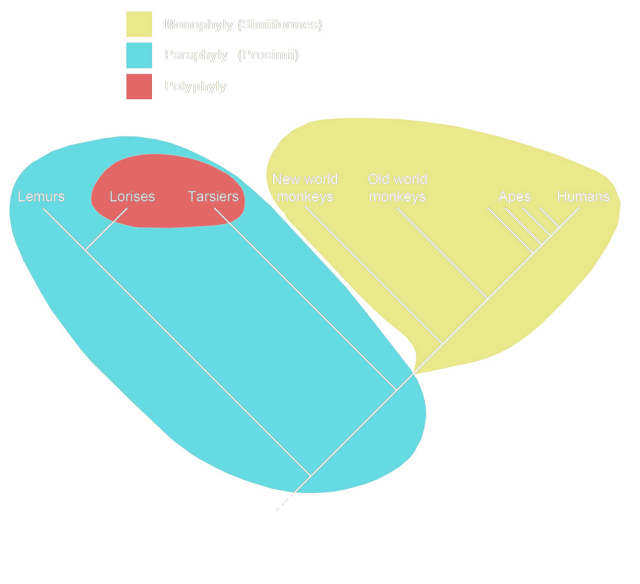Over the course of the past year, I’ve silently admired the emergence of a community of blogs influenced by the writings of Mencius Moldbug who call themselves neoreactionaries. It’s generally been one of the more creative parts of the dissident Right blogosphere, using many of the concepts pioneered by Moldbug and using them in new ways to look at today’s society. However, one of the pitfalls of creativity is that it generates bad ideas just as adeptly as it generates good ones.
One of the ideas that has emerged is a cladistic look at ideologies, with a focus on American progressivism in particular, as exemplified in this post by Nick Land and this more recent one from Foseti in which progressivism is treated as a highly modified branch of English Puritanism. In biology, cladisitics is an approach to categorization of organisms based upon the time since the most recent common ancestor. I like this approach since the categories it generates reflect the actual relatedness of their constituent species. For instance, take this example of primate classification from Wikipedia:
 As can be seen, the old categorical divisions within the order of primates did not reflect the actual relatedness of its species, as tarsiers, classified as prosimians are more closely related to all simian species than they are to the lemurs and lorises that complete the category of prosimians, making “prosimians” paraphyletic. Another example of paraphyly can be seen further up the tree, as there are two branches labeled as “monkeys”, but old world monkeys are actually more closely related to humans and apes than they are to new world monkeys. Similarly, this approach shows that grouping together tarsiers and lorises, two big-eyed nocturnal primates, results in pulling two groups from different branches in a single category, not unlike grouping sharks and whales together despite their very different ancestries.
As can be seen, the old categorical divisions within the order of primates did not reflect the actual relatedness of its species, as tarsiers, classified as prosimians are more closely related to all simian species than they are to the lemurs and lorises that complete the category of prosimians, making “prosimians” paraphyletic. Another example of paraphyly can be seen further up the tree, as there are two branches labeled as “monkeys”, but old world monkeys are actually more closely related to humans and apes than they are to new world monkeys. Similarly, this approach shows that grouping together tarsiers and lorises, two big-eyed nocturnal primates, results in pulling two groups from different branches in a single category, not unlike grouping sharks and whales together despite their very different ancestries.
Cladistics gets its name from the branch-like structure found amongst all life on earth at and above the species level. One way to interpret this branching structure is to group any given organism as a member of all the branches from which it stems. Thus humans would be apes, monkeys, primates, mammals, tetrapods, fish, vertebrates, and animals. While some of those labels, particularly from the smaller categories, may strike you as odd, considering that humans have been historically considered to be a separate category from apes and apes and humans separate from monkeys, it does more accurately capture the relationship that we have to the rest of the animals in those groups.
However, when looking within species, the picture gets more complicated. Here is a graphic from a recent Nature paper (for some background, see this Carl Zimmer article in The New York Times) modeling the ancestries of various groups of modern humans as well as two ancient subspecies who have had their DNA extracted and genomes analyzed: the Denisovans and the more familiar Neanderthals:
While the model still features an intelligible tree structure, it’s complicated by intermixing events between the groups studied, making the tree more web-like and making the answers to questions like “Are Europeans Neanderthals?” more complicated than a simple yes or no.
At the level of modern human races, cladistic analysis fails. A simple case to show this is the Uyghur people. Here is a picture of a Uyghur girl taken by Michael Manning:
As is readily apparent, she has blond hair as found in Europeans combined with the almond-shaped eyes characteristic of East Asians. Uyghurs live in Northwestern China and are the result of the mixing of two groups of people about a millennium ago, likely the Indo-European speaking Tocharians and a Turkic speaking group from the Asian steppes. The result is a population that’s neither West Eurasian (Caucasian) nor East Eurasian (Mongoloid) while being both at the same time. Admixture is a pretty intuitive concept, but because cladistics relies on trees, it fails when the branches merge back into each other.
The point of this long exploration of the effectiveness of cladistic analysis when comparing species vice races is that the ancestry of ideologies shares much more in common with that of races than it does with species. Ideas are quite promiscuous and though they track to some extent with geography and the cultures whence they originated, there are no barriers to recombination, making their relationships much more web-like than tree-like.
American progressivism in particular has borrowed and blended ideas from a great many sources, some of which include English Puritanism, but certainly not all or even a majority of its essence is of that provenance, having borrowed from the French Enlightenment, Marxism, and Judaism besides the contributions from British Calvinism. While digging through an ideology’s past can be quite informative and the links between progressivism and New England Puritanism are interesting, treating that past cladistically is bound to lead to a less, rather than more, accurate picture of what we face in the Cathedral.





Agreed. I think the only reason Moldbug focus so much on Puritanism is to exonerate the Jews from being blamed for the whole thing. And I still don’t get why Land likes cladistics so much.